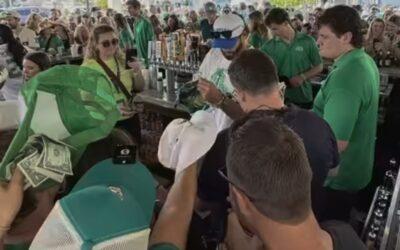On the night of Friday, March 24th, a chemical plant in Bristol, Pennsylvania caused a toxic spill, potentially contaminating the drinking water of Philadelphia residents and many other communities in Bucks County. Trinseo Altuglas, a producer of acrylic products, spilled somewhere between 8,100 and 12,000 gallons of a latex finishing solution into a creek that feeds into the Delaware River. Officials noted that the spill includes chemicals like ethyl acrylate, methyl methacrylate, and butyl acrylate, all of which are harmful to humans. If butyl acrylate sounds familiar, you may recognize it as one of the hazardous chemicals released into the environment by the February train derailment in East Palestine, Ohio.
Officials monitor the water supply for health risks
In an announcement on March 27th, Mike Caroll, deputy managing director for Philadelphia’s Office of Transportation, Infrastructure, and Sustainability, noted that any spill conditions would be resolved by Thursday (March 30th) at the latest. By then, the chemicals will have flowed past the city’s treatment plant. Coast Guard officials have stated that there have been no signs of environmental impact from the spill, like dead fish, and have collected over 60,000 gallons of contaminated water from the Delaware in their monitoring efforts.
The Philadelphia Water Department has been continually testing the water since the incident. As of Tuesday, March 28th, they have shown no evidence of contamination in Philadelphia’s water supply. So far, however, they have only confirmed the safety of the water in increments, announcing periodically that water will remain safe to drink and use through to the next day.
Chemical spills from Bristol plants: a short history
This most recent chemical spill in the Delaware River is far from the first to come from a Bristol plant. The facility owned by Trinseo is just one of a cluster of facilities owned by industrial companies in Bristol situated on the Delaware. Accordingly, organizations like the U.S. Coast Guard and the Environmental Protection Agency continually monitor the area for evidence of spills or contamination – with good cause, as there have been more than a few incidents at this site.
In the last ten years, the government regulators have detected at least four contamination incidents involving acrylate releases.
- 2010: The Arkema plant leaked 1,760 pounds of methyl methacrylate during a transfer to a storage tank. According to the EPA report, “excavation and disposal of the contaminated soil” was necessary.
- 2014: The DOW chemical plant triggered a shelter-in-place order for a local school and a facility evacuation when they spilled 300 gallons of ethyl acrylate. Records from the United States Coast Guard National Response Center show that remediation efforts required contaminated soil and asphalt to be removed.
- 2020: Having determined that a 60-acre area used for chemical or wastewater processing for over a century (which used to host the former Rohm and Haas facility) was “contaminated with a variety of organic and inorganic chemicals,” the EPA issued a corrective action plan. This plan proposed land use restrictions, continued monitoring of contaminated groundwater, and soil remediation.
- 2021: The Coast Guard detected another leak involving methyl methacrylate and identified an Arkema pipeline as the source.
Regarding the chemical spill on March 24th, Trinseo has stated that their acrylic polymer overflowed their onsite containment system due to equipment failure and entered a storm drain. They have since voluntarily paused all operations at the plant and intend to dedicate their full resources to handling the consequences of the spill and investigating their material-handling processes and equipment. Following an internal review, they expect to resume partial production within the next few days.
